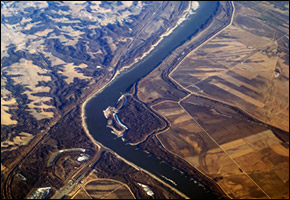In the Mississippi Delta, No Choice but to Drown

A new study in Monday’s issue of Nature Geoscience reports “significant” drowning of the Mississippi River delta is “inevitable” over the next century due to the dual threats of insufficient sediment supply and rising sea levels worldwide.
The report, by Michael D. Blum and Harry H. Roberts of Louisiana State University, estimates that with no new sedimentary input, 10,000-13,500 square kilometers of coastal wetlands could be lost to the sea by the year 2100.
Sustaining the existing delta surface area would require no less than 18-24 billion tons of new sediment — a fact complicated by the estimated 8,000 dams in the Mississippi’s drainage basin, which have reduced the river’s sediment load by half.
Below St. Louis, the Mississippi has effectively been turned into “a pipe,” Roberts said in an interview with The New York Times. Getting sediment down into the marshes along Louisiana’s coast “is not happening, at least not very efficiently,” he added.
Today, Mississippi sediment deposits range in thickness from less than 10 meters near Memphis to more than 100 meters in the far-downstream areas of Plaquemines Parish, near the mouth of the river — the product of 12,000 years of Holocene delta-plain construction, averaging 230-290 million tons a year. Using that rate as a benchmark, Blum and Roberts studied the effects of the thousands of dams on the Mississippi, finding that sediment load dropped remarkably after they had been built.
While pre-dam load met necessary replacement levels averaging about 400-500 million tons per year, data for the period 1976-2006 showed that sediment load was only 205 million tons per year for the lower Mississippi. Faced with a supply deficit, the delta is succumbing to subsidence and losing ground to rising sea levels, which are increasing at a rate at least three times higher now than during the original delta-plain construction.
In other words, if the river started all over again, the Mississippi delta would be very different, covering a much smaller area.
But sediment deficit is only part of the problem. Rising sea levels, which Blum and Roberts estimate will accelerate linearly from three millimeters per year now — according to data supplied by the UN’s Intergovernmental Panel on Climate Change — to four millimeters per year by 2100, combined with subsidence over time, will cause “land surfaces that are now below one meter in elevation [to] be converted to open water or marsh”, according to the research. Indeed, with around 7,000 square kilometers of delta already below sea level, the threat of rising tides is close.
Under the four scenarios that Blum and Roberts laid out for sediment supply and sea level change, only one was able to envision the current delta landscape in 2100:
- Modern sediment loads and sea level rise of 1 mm/year: mass deficit of ~1-5 BT of sediment by 2100
- Modern sediment loads and sea level rise accelerating from 3 mm/year in 2000 to 4 mm/year in 2100: mass deficit of ~11-17 BT of sediment by 2100
- Pre-dam sediment loads and sea level rise of 1 mm/year: sufficient sediment load to sustain the delta plain through 2100
- Pre-dam sediment loads and sea level rise accelerating from 3 mm/year to 4 mm/year: mass deficit of ~3-9 BT of sediment by 2100
Breaking open the dams, then, will not save all of the delta. And according to Roberts, the increased sediment flow from such action may have drawbacks: although nutrients critical to marshland growth would reach the delta in greater quantities, agricultural runoff and other effluents from the previously-trapped sediment might worsen the water quality at the already polluted mouth of the Mississippi.
Read more here [pdf] and here.
Sources: Nature Geoscience [pdf] & The New York Times








Leave a Reply
Want to join the discussion?Feel free to contribute!